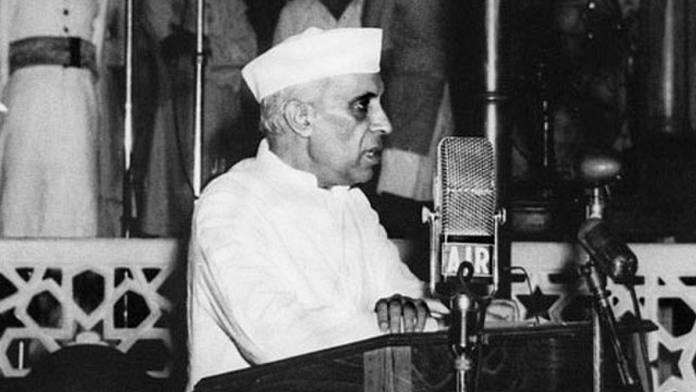Thank you dear subscribers, we are overwhelmed with your response.
Your Turn is a unique section from ThePrint featuring points of view from its subscribers. If
you are a subscriber, have a point of view, please send it to us. If not, do subscribe here: https://theprint.in/subscribe/
On the night of August 14, 1947, Jawaharlal Nehru addressed the constituent assembly with the famous words that continues to echo through the history, his Tryst with Destiny, captured the dreams of a nation emerging from centuries of colonial rule. As he addressed “Long years Ago, we made a tryst with destiny, and now the time comes when we shall redeem our pledge not wholly or in full measure, but very substantially.” These words were not just a proclamation of freedom but a blueprint for India’s future—a call for unity, progress, and responsibility. 78 yeas later, the speech remains a touchstone for India’s identity and aspirations. As India balances its global rise with domestic struggles, the Tryst with Destiny continues to inspire, reminding us of a promise yet to be fully realized.
Nehru’s Tryst with Destiny was a manifesto for a newly independent nation. In his speech he said, “A moment comes, which comes but rarely in history, when we step out from the old to the new, when an age ends, and when the soul of a nation, long suppressed, finds utterance.” Nehru envisioned an India that was united, secular, and forward-looking. His call for “the service of India” to mean “the service of the millions who suffer” inspired policies aimed at uplifting the marginalized. His Vision of India is reflected in the Constitution of India, which emphasizes on equality and justice. The Indian Constitution is more than a document; it is a living entity that protects it citizens through secular and pluralistic thought.
When he delivered the speech communal riots between Hindu Muslim and Sikhs were at the peak. The violence of Partition, which claimed over a million lives, tested Nehru’s vision of unity. In his speech he said, “It is fitting that at this solemn moment we take the pledge of dedication to the service of India and her people and to the still larger cause of humanity.” Tryst with Destiny provides a moral and intellectual framework for India, as it fostered a sense of purpose in a nation rebuilding itself from scratch. Nehru’s speech reflects his commitment to secular, peaceful and plural India where every section of the society is respected and given the opportunity to thrive.
Economically, Nehru’s pledge to end “poverty and ignorance and disease and inequality of opportunity” shaped India’s early development model. His focus on industrialization led to the establishment of institutions like the Indian Institutes of Technology (IITs) and Indian Institute of Management (IIM) and the foundation of India’s space program (ISRO), Medical Institutes such as AIIMS. Globally his, his commitment to humanity’s “larger cause” inspired Non-Aligned Movement which positioned India as a voice for newly independent nations during the Cold War by not aligning with the USA or the Soviet Union. Beyond India’s borders, the speech inspired anti-colonial movements in Asia and Africa, with leaders like Ghana’s Kwame Nkrumah echoing its themes of self-determination.
According to a report published by the World Bank extreme poverty ($2.15/day) fell from 16.2% in 2011–12 to 2.3% in 2022–23, lifting 171 million people, with rural poverty dropping from 18.4% to 2.8% and urban from 10.7% to 1.1%. Employment is growing, with urban unemployment at 6.6% in 2024, but youth unemployment (13.3%) and informal jobs dominate, especially for women. Initiatives like Digital India and the success of startups reflect the spirit of innovation Nehru championed. Yet, economic inequality persists, and issues like caste discrimination and rural underdevelopment linger.
The speech’s call for unity and secularism is especially relevant amid contemporary debates over social cohesion. Communal tensions and questions about freedom of expression challenge India’s democratic fabric, making Nehru’s vision of an inclusive nation a rallying cry for defenders of pluralism. Nehru’s speech was not about casting off the chains of the colonial rule but about rediscovering and expressing the nation’s identity and potential. He called on the people to embrace the future with wisdom, humility, and a commitment to the ideals of peace justice, urging India to play its part in shaping a better world.
Today the speech invites reflection, Jawaharlal Nehru’s Tryst with Destiny was a promise made at the dawn of independence—a vision of an India that is free, united, and prosperous. 78 years later, it remains a mirror reflecting both India’s triumphs and its unfinished tasks. In 2025, as India navigates its role as a global leader while grappling with internal challenges, Nehru’s words remind us that destiny is not a gift but a responsibility. As we celebrate India’s journey, let us recommit to ensuring that the “midnight hour” of 1947 continues to illuminate the path to a brighter, more inclusive future. The tryst is not over; it is ours to fulfill.


Very nice